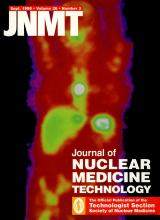Abstract
Objective: This study examined the effects on SPECT quantitation caused by erroneous size and position of the attenuation map and inaccurate pixel size used in the Chang algorithm.
Methods: Projection data of a three-dimensional head phantom were simulated with a uniform attenuation coefficient of 0.15/cm for the inside of the phantom. Images were reconstructed using the filtered backprojection algorithm without attenuation compensation and the Chang algorithm with different attenuation maps. Quantitative comparison then was performed between the reconstructed images and the phantom.
Results: The pixel values obtained for noisy data by using the first-order Chang algorithm with an accurate attenuation map were less than 10% different from the true values and the left-right asymmetry was under 5%. Small errors in the geometric parameters of the attenuation map, however, caused considerable quantitative inaccuracy in the reconstructed image. For example, a 0.64-cm error in the size of the map caused 10% deviation from the true value and a 0.64-cm shift of the position of the map towards the left produced 10% left-right pixel value asymmetry.
Conclusion: The accuracy of the Chang algorithm critically depends on the geometric parameters. For a uniform attenuator with symmetric geometry, such as the human brain, a true left-right symmetry in the pixel value can be altered significantly by a small error in the geometric parameters, while symmetry can be maintained with no attenuation compensation.







